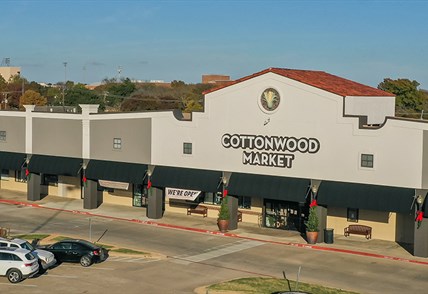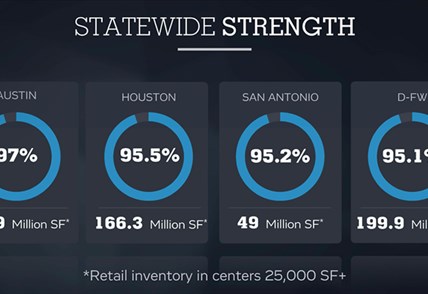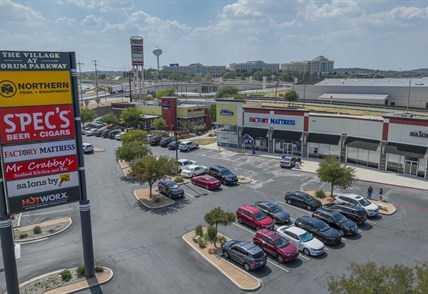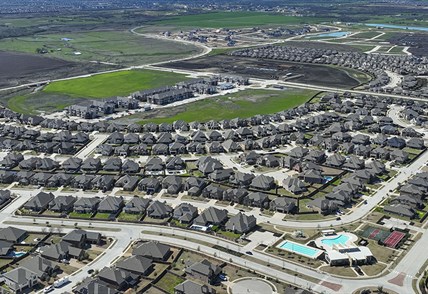By Ian Pierce, VP-Communications
HOUSTON - Houston’s retail market as of mid-year 2017 reports an occupancy rate of 95.1 percent, an extremely healthy rate that remains stable compared to the 95.6 percent rate posted as of year-end 2016.
While the occupancy rate remains near the highest ever recorded for the market, vacancy reported a slight increase due to some box closures, including three Macy’s and three Gander Mountain stores, which together accounted for nearly 1 million square feet of vacancy.
THE FULL REPORT, with retailer and property details, can be found at http://www.weitzmangroup.com/report
The outlook for these properties is strong, as Houston has an excellent track record of backfilling vacant boxes with good retail locations. Further, the closings represented only a rounding error for a market with more than 150 million square feet of retail inventory.
Anchors leasing space in existing retail space for 2017 include: T.J.Maxx, HomeGoods, Total Wine & More, Life Time Fitness, Pet Supermarket, Nordstrom Rack, Dick’s Sporting Goods and others. Spaces being backfilled include former Fresh Market stores and former Sports Authority stores.
The retail market is benefitting from the continued strength of the Houston economy, which despite the loss of numerous energy-sector jobs, still reports an unemployment rate of only 5.1 percent as of mid-year 2017, according to the Texas Workforce Commission. The rate actually represents an improvement over the 5.7 percent rate posted as of January 2017.
One reason for the continued positive job growth is that the segments of the economy that work in the “downstream” market of refineries and chemical plants actually benefit from lower oil prices.
And despite the oil market’s well-publicized weakness, which has resulted in significant amounts of office sublease space in submarkets serving the energy-exploration firms, the overall metro area’s economy has remained in the positive column, with job, housing and population growth.
Weitzman reviews a Houston-area retail market inventory of approximately 155.3 million square feet in multi-tenant retail centers with 25,000 square feet or more.
For calendar year 2017, the Houston-area retail market is on track to add approximately 2.7 million square feet of retail space in new and expanded projects, bringing the total inventory close to 160 million square feet.
The 2017 construction total would represent a decline in new space when compared to 2016’s 3.4 million square feet of retail space.
The new space is resulting in part because of the completion of the Grand Parkway, which opened access and visibility to the suburban markets such as Katy and The Woodlands. Due to this new access, the majority of ground-up construction is occurring in the Grand Parkway corridor.
The appeal of Houston’s densest neighborhoods is also generating a new round of redevelopment projects, many of which are in the Heights, EaDo (East Downtown), in Bellaire and in other dense districts.
For 2017, the majority of new retail centers are dominated by power and grocery store anchors. The largest new project is Valley Ranch Town Center, a major regional-draw project designed for retail and entertainment space, where Kroger Marketplace and Sam’s Club opened during the second quarter 2017. A new phase is now underway for T.J. Maxx, Burlington Coat Factory, PetSmart, Ross Dress for Less and others. The new phase brings the center to a total of 600,000 square feet. Upon completion, the project will total more than 1 million square feet. Academy Sports & Outdoors opened at Valley Ranch Town Center in 2016.
Other new projects feature anchors Kroger, Target, H-E-B, Walmart Supercenter, Burlington Coat Factory, DSW, PetSmart, T.J.Maxx, Michaels, Hobby Lobby, Academy Sports & Outdoors and others.
For 2018, we expect to see overall retail construction decline over 2017’s level. But it will still represent the expansions of major anchors in the market, reflecting ongoing demand for key Houston retail locations.
For the remainder of 2017 and going into 2018, the market shows itself on track to maintain its healthy occupancy, thanks to economic growth, notable leasing activity and new construction that remains primarily demand-based.




